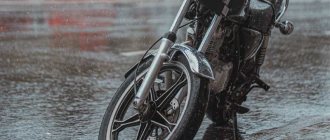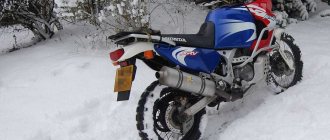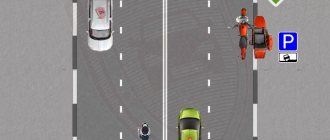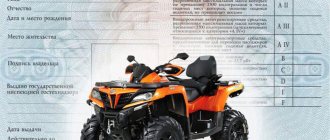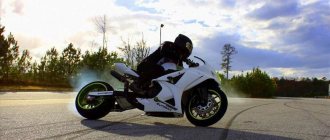It is widely known that car drivers and motorcyclists do not like each other, and sometimes they are even enemies fighting for influence. People traveling on the road by car believe that they have more rights than motorcyclists or other road users, although the traffic rules do not give them this right. Motorcyclists often create dangerous situations on the road with their reckless and even brazen behavior.
What should a driver do to ensure a safe motorcycle ride?
Tip 1 – motorcycle riding culture
A motorcyclist is not a more privileged road user than a car or bus driver. No one is forced to change from the left lane to the right to make room for a speeding biker behind them. However, if the driver does behave this way, it is good to thank him for it - with a nod or a raise of his hand. You should always signal your desire to change lanes and ensure that no one behind you attempts a similar maneuver. Thanks to this, you will avoid danger on the road.
Let's start the engine
So, you are finally ready to start the engine. First of all, you should do this in a deserted place - this will significantly reduce the likelihood of unforeseen situations. We will not dwell on the technical side of the issue - each model has its own characteristics, so there is no point in talking about it. Let us only emphasize that the basics of motorcycle control emphasize several nuances:
- Train yourself to keep your fingers on the brake lever. In case of unforeseen events, this will help save a split second, but it is often enough to save your life;
- try to stay close to the left lane. On this stretch of road, there will generally be slightly better traction as oil from the vehicles' pans drips onto the middle of the strip. The difference is insignificant, but it can also affect the final result;
- never forget about your equipment. And this doesn't just apply to the helmet. Having a protective jacket made of durable materials, high-quality trousers, elbow pads, and knee pads is not posing, it is a real way to protect yourself from injury.
Tip 2 – Adjust the speed of the motorcycle
Under no circumstances should a motorcyclist treat the public road as a race track to test the performance of his motorcycle. Driving on one wheel, stalling at a crowded roundabout or making sharp turns and burning rubber at traffic lights are ways to create dangerous situations. It also reinforces the belief that motorcycle users are reckless, arrogant and irresponsible.
We drive our own bike
Yes, the theory of driving a motorcycle is good. But, at the same time, no lessons will teach you how to drive correctly. To begin with, you should familiarize yourself with your vehicle in as much detail as possible. But it’s too early to get behind the wheel; first you need to feel the mass and center of gravity of the device. To do this, we simply take and drive our bike (we actually drive, so that the owner himself walks next to his iron horse).
First, we remove the bike from the stand, take it by the handlebars, tilt it slightly towards ourselves and push it. When we learn to move forward, we begin the journey counterclockwise. You can complicate the task by going around the circle clockwise - the motorcycle will fall out of your hands, so you will have to make additional efforts.
Such exercises are very useful as the muscles get used to how to properly balance a motorcycle . In addition, this will allow you to understand how to apply braking at a reflex level (especially if you are training in terrain with small hills).
You may also be interested in: Do I need to get a license for an ATV?
Tip #3 – Don’t race between cars
"Attention! Motorcycles are everywhere » Motorcycles usually travel faster on the road than cars, so they can flash in the driver's mirror without him noticing the rider. Unfortunately, the consequences of this situation can be tragic.
Online traffic rules exam 2022 in the traffic police - traffic rules tickets with answers
Therefore, a prudent motorcyclist will ride so that others can see him. The motorcyclist should always be aware that the driver of the car may not be able to see him in the rear view mirror - it is important to maintain an appropriate safe distance from the vehicle, avoid and, if necessary, adjust the speed. The so-called principle of limited confidence, because due to inattention, lack of sufficient visibility or ordinary human stupidity, an inattentive driver can change lanes into a motorcyclist when changing lanes.
Survive until closing: 10 rules for safe driving in the fall
Closing seasons have died down, most Moscow motorcyclists have hidden their motorcycles in garages, and only the most desperate riders remain on the roads. Some people are simply not cold, some want to travel as much as possible before the long and cold winter, while others physically cannot “lock up” - working on a motorcycle has become increasingly popular in recent years. Whatever the reasons push you to ride in deep autumn, this material will be useful to you, regardless of the number of successful and not so successful seasons.
Now, when temperatures drop to below zero at night and barely exceed 1-2 degrees during the day, equipment becomes especially important. Your hands, feet and neck will be cold, so you need to insulate them with special care.
Warm your hands
Good, warm gloves are a must. There are winter motorcycle ones on sale, but snowmobile ones are also suitable, the main thing is that it is comfortable to turn the gas and press the levers. Is it uncomfortable to ride in thick gloves? Just dense ones, without ventilation, with heated handles will also work. By the way, the most budget options for “warm” handles will cost about the same as gloves, so the choice is yours.
Heated handles, coupled with lever protection and waterproof gloves, will ensure hand comfort even at sub-zero temperatures
As an alternative, you can consider warm covers on the steering wheel grip, which can be combined with handle protection: in this case, accidental pressing of the brake and clutch is excluded. And if you don’t have any money at all, here’s a life hack shared by experienced riders: take cheap rubber boots, or better yet, old felt boots, cut off the toes from them and put them on the handlebars through the resulting holes. Wrap with tape and enjoy wind protection and comfort even in sub-zero temperatures. The main thing is to be careful when installing - in the extreme positions of the steering wheel, such a “tuning” should not cling to anything and under no circumstances should it press the brake and clutch levers.
Protect your visor from fogging
The head will be warm in any integral helmet, so all tuning of the helmet should come down to installing a visor with a pin-lock or, if one is not available, treating the glass with a special compound that prevents fogging. As an alternative, you might consider purchasing a snowmobile helmet with a double-pane lens and a heated visor.
Read also: Everything you need to know about choosing a motorcycle helmet
But the wind will blow especially strongly on your neck - buy a windstopper, a balaclava or wrap yourself in a scarf. Any of these solutions will significantly increase comfort, especially on long hauls.
To combat visor fogging, you can use special sprays, pinlock, double glass or a heated visor
Choose the right equipment
A winter motorcycle jacket will be extremely difficult to find, but in near-zero temperatures, a simple raincoat worn over a set of good touring gear and winter thermal underwear will suffice. And if it’s cold, buy the cheapest synthetic padding pants and a simple padded jacket at a workwear store. It looks creepy, but it will be extremely difficult to freeze.
To protect your body from the cold, you can use a set of tourist equipment and a raincoat
Keep your feet warm and dry
But you shouldn’t experiment with boots - riding in felt boots is simply unsafe, and switching gears in winter shoes is extremely difficult. That is why it is better to choose thick hiking boots without ventilation and warm socks, and to keep your feet dry, you can glue a couple of women's pads to the insoles - they absorb moisture well.
Waterproof, warm motorcycle boots will be useful not only in autumn and winter, but also during rainy summers
Become More Visible
There are fewer and fewer motorcyclists on the roads, which means other road users are beginning to look in their mirrors less often. In addition, daylight hours are becoming shorter and shorter, and you have to drive at dusk. That's why don't be shy about snarling, wearing a bright reflective road worker vest, and flashing your high beams. This is not rudeness, but a way to survive.
In the rainy autumn twilight, do not neglect additional lighting and bright equipment
Remember the cold asphalt
As we have already said, drivers are less and less ready to meet you every day. However, the dangers do not end there - on cold asphalt the tires warm up much worse and the “hold”, if not completely lost, then noticeably decreases even on a dry surface. What can we say about rain, snow, mud, slippery rotten leaves and shampoos that are used to treat roads before winter. And this does not take into account the fact that by November, the motorcycle is shod with tires installed, at best, at the beginning of summer!
Fresh rain tires will be a good safety net on wet and cold asphalt.
Accelerate smoothly
With the arrival of cold weather, the braking distance increases greatly, and the braking itself sometimes becomes very unpredictable. In this regard, it is a little easier for owners of motorcycles equipped with ABS and traction control - electronics take on part of the work, but in percentage terms there are not many such lucky ones. That's why forget about sharp throttle openings in turns, effective decelerations and deep leans into turns.
Autumn is a time to remember the rules for moving on slippery surfaces
Slow down the pace
At the same time, it is necessary to reduce the average speed. Experienced riders and owners of modern motorcycles can be advised to limit themselves to the notorious +20 of the flow speed, and for everyone else to generally slow down to car speeds.
Of course, this will increase the danger that, for example, they will change your mind, but in this case you have to choose between two evils. And be careful in the aisles - there you can often find markings that you can slip on in the rain and with a slight advantage even on good tires.
Wet fallen leaves and fresh markings can play a cruel joke on an unprepared motorcyclist
Don't tilt the motorcycle
Turns are a different story. On a slippery road, you need to lean the motorcycle as little as possible, which means the pilot will have to lean more into the corner. In fact, your task is to leave the motorcycle in the most upright position, compensating for the centrifugal force with your own body. The more you hang over, the more vertical the motorcycle remains, the more difficult it will be for it to get away from under you.
On slippery roads, you need to keep the motorcycle as upright as possible - use your body
Prepare the motorcycle
In the fall, the roads begin to be watered with reagents, from which everything and everyone begins to rust. It is clear that the motorcycle will look worse from trips in the fall, so we can advise all off-season enthusiasts to wash the motorcycle at least once a week, and then fill it with some kind of preservative lubricant, be it silicone or penetrating. This will partially save the situation.
Read also: How to buy a motorcycle and not make a mistake – 50 tips for choosing used equipment
It is especially important to do this before wintering - if you park a motorcycle covered in salt and reagents, even in a warm garage, you are at great risk. Most likely, in the spring you will return to something that more closely resembles a coral reef of brown rust and white oxides on aluminum. It is clear that in most cases it will be possible to put it in order and restore its former luster, but these procedures will cost much more than banal washing and preservation.
If you ride actively in the fall, you should wash your motorcycle from salt and reagents at least once a week.
Following these simple recommendations is a great way to extend your motorcycle season by a couple of months. However, if traveling on the roads has become boring, you should pay attention to off-road trips - for the happy owners of enduro motorcycles, the concept of “season” practically does not exist.
Subscribe to Omoimot VKontakte, Facebook, Google+ or Twitter to be the first to receive announcements of the most interesting materials wherever it is convenient for you.
Cover photo – Matthew Jones Photos in this article belong to their respective authors.
Tip 4 – Be careful like a motorcycle driver
Safe motorcycle riding requires keen vigilance. The behavior of other road users should be expected. You should also make sure that you are clearly visible on the road even in adverse weather. A jacket with reflective inserts and a brightly colored helmet will definitely increase the likelihood that other drivers will immediately notice the rider.
Asking a friend for help
If you have a friend who knows how to ride a motorcycle well, this is just an ideal option . He will show, and tell, and help. On the other hand, if such a friend is absent, it is still worth inviting someone for the first test drive. As already mentioned, most trips end on the ground, and it’s good if everything ends with a slight bruise. But if the injuries are more serious, it is important that you can receive first aid and call an ambulance. Finally, there will be someone to help drag the vehicle to the garage.
Tip 5 – Improving your motorcycle riding technique
Motorcycle users often think they are great at riding and don't need to learn anything else. However, self-improvement in motorcycle riding techniques will improve your safety and get more pleasure from riding two-wheeled vehicles on the road. Vocational training for first and second degree motorcyclists is offered, in particular, by motorcycle driving schools, which have developed an effective training program.
It involves performing basic exercises to improve motorcycle riding technique, as well as working to maintain proper balance. Thanks to completing the courses, the motorcyclist will perform maneuvers accurately, will be able to brake safely and urgently from different speeds, and will be able to behave in difficult situations on the road.
Post Views: 1,815

